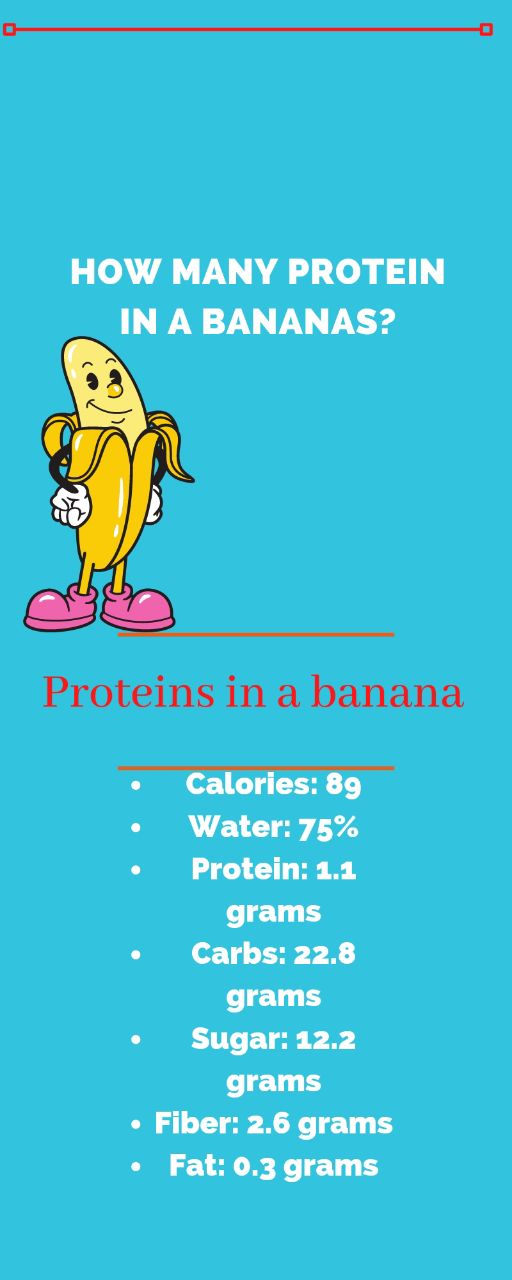how many proteins in a banana?
Bananas benefits
We’ve previously explored protein production in green bananas (Actinomycetes) and bananas that are irradiated to grow more effectively (Caenorhabditis). This time around, we’ll look at protein yield in banana cells.
Bananas contain High protein-rich teen rich food,
Protein in fruits and vegetable chart
This is a particularly interesting topic because after a plant has produced banana proteins for you to use in your diet, the plant continues to produce them for those cells that were not consumed. I wouldn’t necessarily consider this as a bad thing.
How many proteins in a banana?
- Calories: 89
- Water: 75%
- Protein: 1.1 grams
- Carbs: 22.8 grams
- Sugar: 12.2 grams
- Fiber: 2.6 grams
- Fat: 0.3 grams
For example, a regular banana plant produces protein as well as chlorophyll during all its stages of growth, and when it dies (anamorphosis), it produces proteins in an aspic form:
(a) a cell can be anamorphic, so long as it is dormant. If a banana plant is alive when it’s dormant, then it will be asphyxiated. But this is the way things naturally work, and we simply need to accept this fact.
(b) If a banana plant is alive when it’s grown for a particular purpose (rather than being dormant), then it will reproduce itself
so it will become more productive, adding more protein to its cells.
It is for this reason that one banana plant can, in the same season, produce more protein than all the banana plants in your garden.
So how does this happen? Well, we can observe that when a banana plant is planted (or grown) in a location where it has adequate food (in this case, chlorophyll), the plant doesn’t produce protein at all. But if it doesn’t have sufficient food in another location, it will produce banana protein in the quantity you need. For example, it can grow in banana plantations in the tropics, which have high rainfall (96% of the bananas you see in your grocery store are from plants grown in banana plantations) and fruit that has been treated with high-protein, high-fructose syrup.
What about making protein in bananas?
Now that we know that banana plants produce protein as well as fruit that is consumed by humans, we can look for specific proteins that are produced by banana plants. So let’s take a
look at this protein curve.
If we observe this protein curve, we’ll see that a large portion of the protein is a monomer:
(a) this is one protein, which is a large protein in the case of bananas (and lots of proteins in general), but it’s the smallest protein that you can see in a protein diagram. The banana plant has many different types of proteins.
How can we tell which protein type is produced by a banana plant? Take a look at this picture.
For example,
we can see that this plant produces a protein that is made up of a long protein chain (the large portion of the picture). As you can see from this picture, the protein chain is made up of many proteins that are not normally seen as separate proteins in a protein diagram (this is an illustration, not a picture of banana proteins, and you can click on the picture to see the picture with different colors).
So this is how we can distinguish different types of protein. Remember, it’s not always that there are two (or more)
protein types produced in a single plant. For example, you’ll see that the protein from banana plants produced in the dry environment looks like this:
(b) this protein is not always produced by a banana plant in a dry environment, especially in banana plantations. As well, this protein type is not always produced by bananas that are grown in the rainforest, because these plants grow in a constant moisture environment.
But banana plants can make a banana protein that is only produced by bananas in dry environments. This protein may not be expressed when the plant is growing in the rainforest, but it’s still produced in abundance in banana plantations, where the plant is exposed to dry conditions.
This is the protein we need to target with our vitamin supplements to improve banana protein yield:
(c) we don’t necessarily need to concentrate on adding extra proteins to a plant; we can just concentrate on removing proteins in banana plants that are no longer needed.
# how many proteins in a banana mean the banana is ripe and how much protein is in a banana (and protein calories).
I have written a somewhat pedantic article called How Many Pgs Of Protein Are In A Banana Is Up To You
You see I find myself making up numbers all the time. For a long time, I used 15 pp of protein for every 100 grams of protein.
But eventually, I decided that people are not interested in figuring out which protein intake was realistic, they wanted to know what foods had a reasonable amount of protein.
We do need to get more protein from our diet, and we do need to get the right amount of protein in our diet. We do need to have more protein, we do need to get the right amount of protein.
But I am willing to concede that any number I give, the vast majority of people will never know or use. They don’t need to, they shouldn’t, because it doesn’t matter.
What matters is that we get the nutrients that our bodies need and that we get them in a form that they can use.
It is better to get a proper amount of protein than it is to have a free meal of almost unlimited protein that only ends up wasting our nutrients.
Still, I feel it is important for anyone interested in getting the most nutrients possible from their diet, to know what protein intake is realistic, and what is too much.
If you want to make a rough guess, you can make a rough calculation of protein intake using a rough formula (1 kcal x 3.5 g x 8 hrs = protein):
calories x 3.5g x 8 hrs = protein
In other words:
1 kcal x 3.5g x 8 hrs = protein (this is very rough. It would take you at least a month of solid protein consumption to get a very accurate number).
Or if you want to do the calculation as an app you could use the calculators that Google provides. Or you could look up the dose for protein per kilogram.
Here is a quick look at some other protein-related numbers that might be of use:
The total amount of proteins in a typical protein drink:
According to those calculators, you need a protein drink with 60 g protein (or 24 g protein per 30g cup). That is 288 g protein.
The amount of protein you get from eating 50 g of protein:
According to my calculations, you need 1.5 grams of protein per kilogram. That is 36 grams of protein per kilogram.
So you get about 9 g protein per kilogram of protein consumed.
According to the exact formula used, you need 22 grams of protein per kilogram of protein to get 1 gram of protein from protein supplements, so you will likely get at least 4 grams of of of of ms protein from your protein powder.
That means you get 24 grams of ms protein per kilogram of protein if you do the math right.
How much protein do you eat per day?
According to this article, you can eat 30 grams of protein per kilogram of body weight per day. That is 0.3 grams of protein per kilogram of body weight. That means if you weigh 150 pounds you would of of of of of of of t 0.3 grams protein per kilogram of body weight each day.







